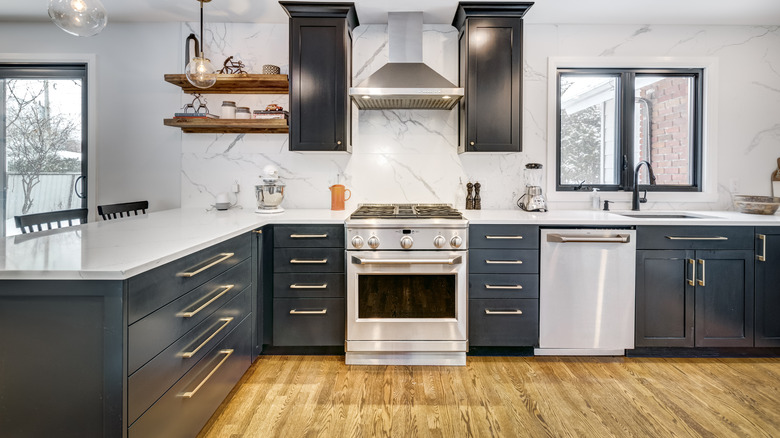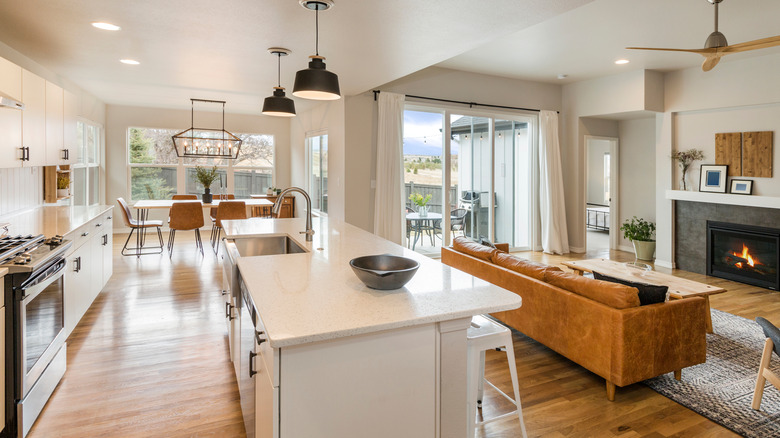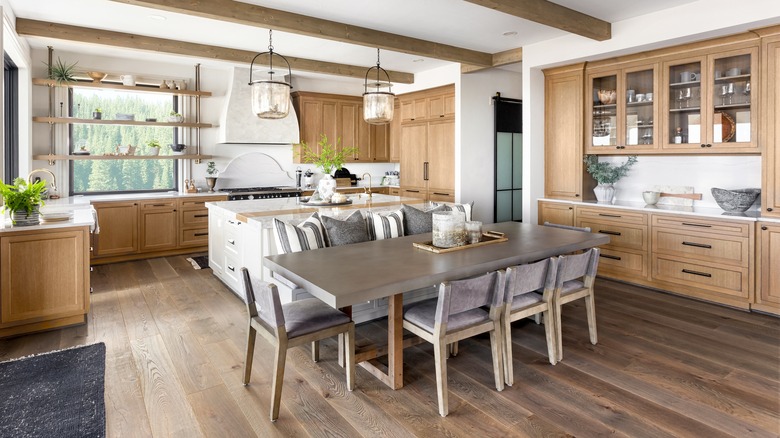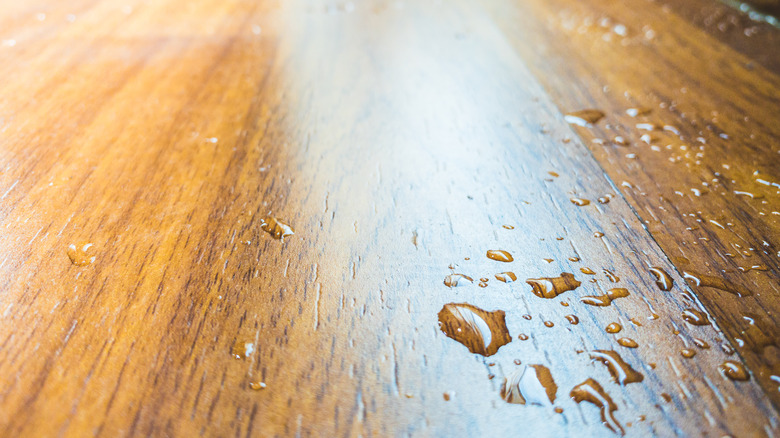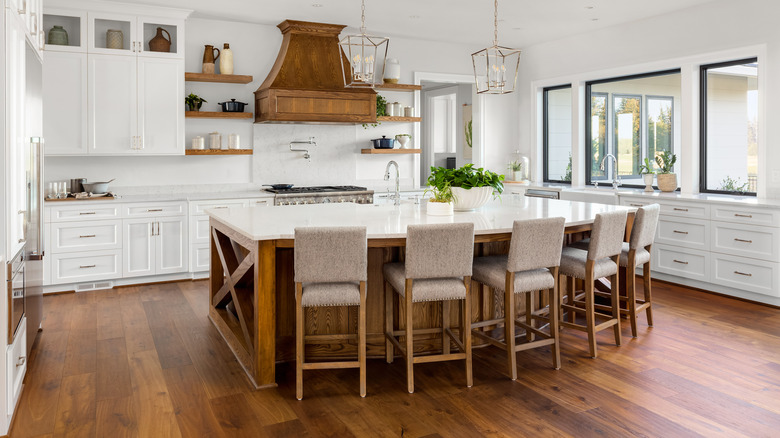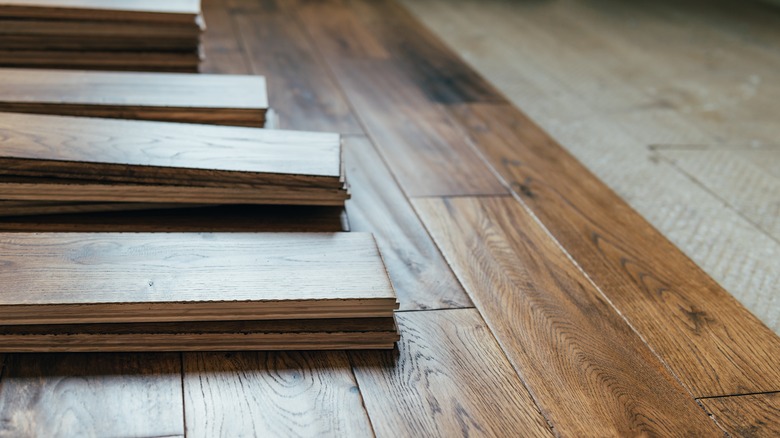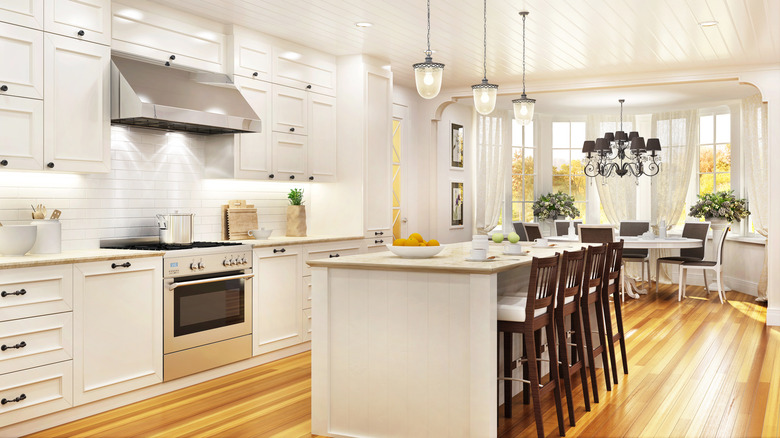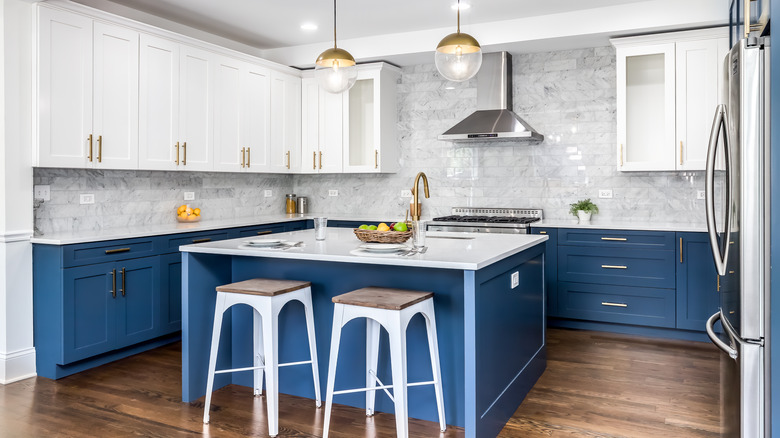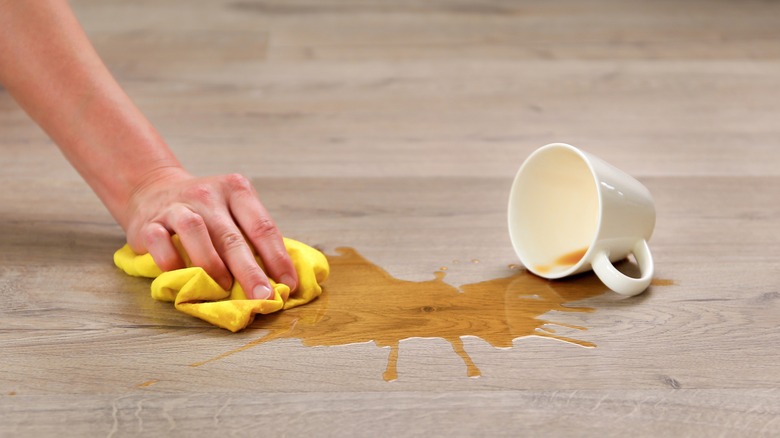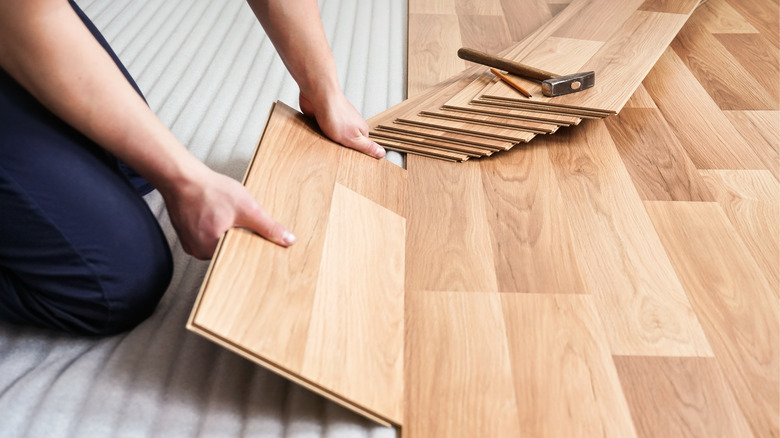What To Know Before You Buy Hardwood Floors For Your Kitchen
Have you been thinking about renovating your kitchen? Or, maybe, you're just ready to finally replace the outdated tile, laminate, or linoleum floor that's currently in there. Either way, you may be considering having hardwood flooring installed in your space, and if so, this piece is for you.
As Kitchen Magic shares, there are several benefits of hardwood floors in the kitchen. With their natural wood grain and multiple color and finish options, this type of flooring can enhance the look of any room in a home. You can find the right style and color of hardwood to match modern or traditional kitchens, and everything in between. Hardwood is also comfortable to stand on, since it stays warmer and is a bit softer than tile. Before you contact a flooring professional or place an order for planks to install your own wood flooring, there are several things you'll want to know. Read on to learn more about the pros and cons of hardwood floors in the kitchen, along with some other factors to consider.
Pros of hardwood floors in the kitchen
When you're making a major decision regarding a home renovation project, one place to start is by thinking about the benefits of the various options you're considering. MacDonald Hardwoods highlights numerous advantages of installing hardwood floors in the kitchen. As they share, several types of hardwood are very durable. Choosing one of the woods that ranks high on the Janka hardness chart shared by Superior Hardwood Flooring, such as Santos Mahogany, can provide you with confidence that your floors will continue to look great and hold up, even with the heavy traffic typical in many kitchens.
Cleaning this flooring is also relatively simple. A weekly vacuuming and once-over with a mop is all that is typically needed to keep them looking their best. Compared to tile, which is hard and cold, hardwood flooring can be more comfortable to stand on. They are softer than tile and stays warmer, especially during the cold winter months. Additionally, hardwood floors can even help improve the air quality in a home. They don't hold allergens, so you may notice improved airflow in your kitchen after making the switch from another type of flooring.
Another benefit of choosing hardwood floors is their beauty. There are several different wood tones to choose from, and each can offer a different feel to enhance the look of a kitchen. Installing them may even make your kitchen feel bigger. When the longer planks span the length of the kitchen, it can trick the eyes into thinking that the space is larger than it is. Finally, due to all of these benefits, hardwood floors can even help boost your home value. Prospective buyers appreciate the beauty, durability, and longevity of these floors and may factor that in when making an offer on your home.
Cons of hardwood floors in the kitchen
While there are several benefits of installing hardwood floors in the kitchen, there are also a few downsides to consider. Weighing the pros and cons of a large investment, such as this one, can help you make an informed decision, rather than one you may end up regretting. According to BuildDirect, hardwood floors are not water-resistant. Spills that are not promptly cleaned up could lead to splitting, warping, or swelling of the wood. If there is a leak in your kitchen that isn't promptly detected, it could cause major damage to the floor, resulting in necessary repairs. Similarly, when cleaning hardwood floors, you will want to use a dry mop rather than a wet mop. The water from the mop could penetrate the floors and cause damage.
Cost is another one of the potential drawbacks to hardwood floors. Having hardwood floors installed will often be the most expensive option compared to luxury vinyl flooring, ceramic tile, or other choices. If your budget is tight, they do make vinyl or tile flooring that looks like wood, which could be a good compromise.
Hardwood floors can be damaged by water
Nydree Flooring explains that wood is a porous material, which means that it will absorb water. Any spills on your hardwood floor can pose a threat, particularly if they are not promptly cleaned up. These spills can stain the wood. Stains, however, could be the least of your problems if a lot of water is spilled or leaks on the wood and gets absorbed. The wood planks could swell, causing them to buckle and become uneven.
Sealed wood can help improve the water-resistance of wood flooring, but they are not the answer to all of your problems. Rather, sealants buy you a little more time to clean up spills without as much threat to damage. Though, if the water is not cleaned up quickly, it can still cause a lot of damage. If you do choose to install hardwood floors in your kitchen, there are steps you can take to minimize water damage, such as soaking up spills and puddles quickly using a towel or mop, keeping wet items off the floors, and leaving a dehumidifier in the room for at least 24 hours after a large spill or leak to make sure that as much moisture is removed from the floors as possible.
Different types of wood offer varying degrees of durability
When it comes to durability, not all wood floors are created equal. As Floor Authority points out, kitchens often see heavy levels of foot traffic. For this reason, it is important to choose a more durable type of wood for the hardwood floors in your kitchen. Approximately 20 different species of wood are used to make hardwood floors. Some of these, such as birch and pine, are softer and are more likely to get damaged, particularly in homes with heavy traffic through the kitchen. Some of the more durable wood options to consider for kitchen flooring include hickory, maple, and oak. A kitchen floor made using one of these species of wood will be the most resistant against damage from pets, kids, shoes, and other causes.
One benefit of wood floors is that you can refinish them if they start showing signs of wear or damage after a few years. When hardwood floors are professionally refinished, it can often restore them to their original beauty and splendor. While you'll still need to pay for professional refinishing, it will not cost you as much as you'd need to spend to put in an entirely new kitchen floor.
Allow the wood to acclimate before installing it
Whether you're installing the new hardwood floors yourself or planning to hire a professional, it is essential to let the flooring acclimate to the home's climate before installing it. Olde Wood Limited explains that the moisture content level of hardwood floors needs to be in equilibrium with the rest of the home. If the floors aren't given sufficient time to acclimate and ensure that the moisture content is consistent with that in the rest of the home, they could shrink or expand after installation. This could lead to serious problems with the way the floor looks and feels and, in some cases, could even cause structural damage to your home. Allow at least three days for your new wooden floors to acclimate to the environment in your home.
To aid the process, it is also a good idea to open up the packages of hardwood flooring and separate them into smaller groups. Doing so will help improve airflow and proper acclimation to the space. For even greater circulation, consider stacking the wooden planks in a crisscross pattern with a spacer between the layers. There are times when your wood floors may require more than the standard three days. For example, if you're using a tropical wood species, give it additional time to acclimate. These types of wood often gain or lose moisture more quickly than other types of wood.
How long do hardwood floors last in kitchens?
Hardwood floors are a long-lasting and durable choice for many homeowners. It's is a myth that hardwood floors do not last very long. When hardwood floors in a kitchen are given the proper care and maintenance, they can last for generations. When you compare this to the few decades that you may be able to get out of tile or engineered floors, the difference becomes clear.
Golden State Floors notes that it is important to prime the subfloor before installing the hardwood to help them look the best and extend their lifespan. If the subfloor is uneven, it could result in uneven flooring throughout the kitchen. To level the subfloor, check for loose sections and use a screwdriver to get them flush with the rest of the subfloor. You can also use a sander to even out rough or bumpy sections. If needed, leveling compound can also help provide the ideal base and support for your hardwood floors.
Hardwood is often more expensive than other flooring options
Choosing hardwood flooring over other types of floors, such as tile or vinyl, will cost you more money. Wood Wise shares some of the reasons why hardwood floors are more expensive. One reason for their higher price tag is the increased demand for products made out of hardwood. This demand has increased to the point that it is nearly two times as high as the rate that new hardwood can grow at. With less trees available, the price of hardwood flooring and other hardwood items is going to be higher.
Installing hardwood floors is also more involved and labor-intensive than installing many other types of floors. It is time-consuming and requires a certain amount of skill and know-how. Even with the technological advancements that we've seen in the past few decades, the overall process for installing hardwood floors is still the same, meaning it still takes about the same amount of time and effort to install a hardwood floor today as it did 20 or 30 years ago. Ultimately, it is up to you to decide whether hardwood floors are worth the investment for your kitchen. Consider the various pros and cons and other information that has been shared to help you determine whether they're the right material for your kitchen and something you can afford to splurge on.
Coordinate the stain with your cabinets and countertops
The last thing you want to do is to install new hardwood flooring in your kitchen only to realize that it clashes with your countertops or cabinets. Choosing the ideal combination of textures and colors among your cabinets, countertops, and kitchen flooring (or stain color) can really enhance the look of your kitchen and give it a more welcoming finish. We recommend starting the design process by doing some research and looking through images of kitchens in magazines or online, and then making note of your favorite ideas and color combinations.
Once you have a general idea of what you're looking for, pick your countertops first. Matching the cabinets and flooring to the countertops will be easier than finding a countertop material that coordinates with a specific cabinet or flooring color that you've already selected. To avoid making your kitchen too busy, aim to have two complementary colors along with one accent color. That means that either your floors, countertops, or cabinets should be in the accent color, and the other two surfaces should complement one another. In addition to considering the colors of each material, don't forget to also consider the texture. Make sure that the different textures you choose go together and match your preferences for the finished look of your space.
Follow appropriate care and maintenance recommendations
If you decide to have hardwood floors installed in your kitchen and want to keep them looking their best for as long as possible, be sure to take care of them. A quick daily vacuuming or sweeping of your floors can go a long way towards maintaining their beauty. In most cases, it won't be necessary to do a deep or thorough clean every day, but you'll want to be sure to clean up any messes on the floor and tackle the areas where crumbs tend to accumulate.
Another tip to help keep hardwood flooring looking great is to use rugs in the kitchen. Place rugs near any exterior doors in the kitchen to catch dirt and debris as people enter the room. In addition to placing rugs near the doors, you should also place them near any areas of the kitchen close to water or that are used for food preparation, such as the dishwasher, stove, and sink. If you have a kitchen table, place a larger area rug under the entire table and chairs to catch crumbs and spills.
We've already shared a bit about why water and wood do not get along, so it shouldn't be surprising that you'll also want to work quickly to clean up any liquids that spill or leak onto the floor. It is also not recommended to use wet or steam mops. A few other tips that can help you extend the lifespan of your hardwood floors and maintain their beauty include placing felt pads on chair legs and taking care when sliding appliances or other heavy items across the floor.
Consider luxury vinyl planks as an alternative to hardwood
If you love the look of hardwood floors, but don't feel like they are the ideal solution for your kitchen, consider installing luxury vinyl planks (LVP) instead. LVP are available in a range of colors and patterns, many of which resemble hardwood floors. LVP are less likely to chip or scratch because of the thick top coating. However, they may dent or become torn if something heavy is dropped on them. LVP are also a more budget-friendly option. Additionally, it is easier to install LVP than wood floors. If you're looking for a DIY project, they may be the better option for you.
One of the main benefits of LVP over hardwood, particularly for the kitchen, is that LVP is more moisture-resistant. They will not be ruined by spills or leaks that are not caught and cleaned up right away. Similarly, LVP flooring can be easier to clean than hardwood floors. You also aren't as restricted regarding the types of cleaning products you can use. For example, wet mops and steam cleaners are fine to use on LVP. One downside is that LVP may fade if overly-exposed to bright sunlight. Installing some blinds or curtains on your kitchen windows can help reduce this concern.
